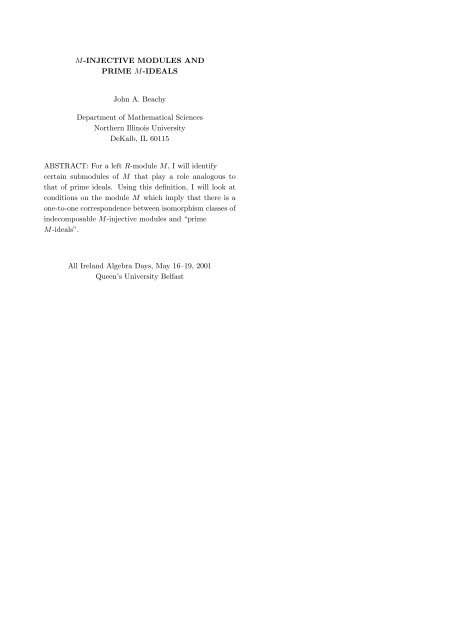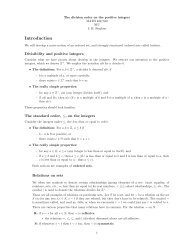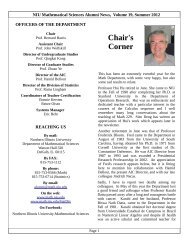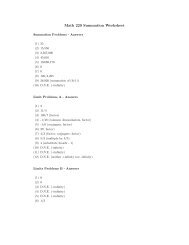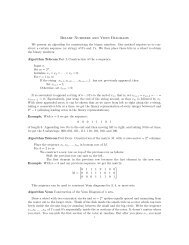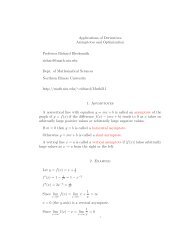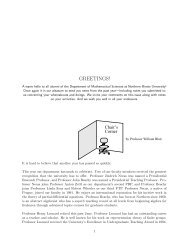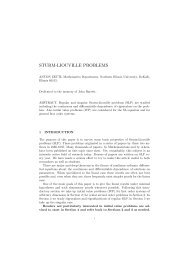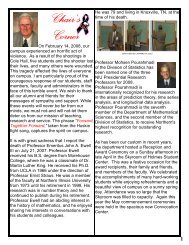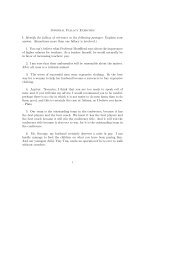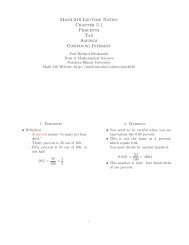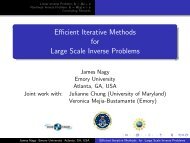m-injective modules and prime m-ideals - Department of ...
m-injective modules and prime m-ideals - Department of ...
m-injective modules and prime m-ideals - Department of ...
Create successful ePaper yourself
Turn your PDF publications into a flip-book with our unique Google optimized e-Paper software.
M-INJECTIVE MODULES ANDPRIME M-IDEALSJohn A. Beachy<strong>Department</strong> <strong>of</strong> Mathematical SciencesNorthern Illinois UniversityDeKalb, IL 60115ABSTRACT: For a left R-module M, I will identifycertain sub<strong>modules</strong> <strong>of</strong> M that play a role analogous tothat <strong>of</strong> <strong>prime</strong> <strong>ideals</strong>. Using this definition, I will look atconditions on the module M which imply that there is aone-to-one correspondence between isomorphism classes <strong>of</strong>indecomposable M-<strong>injective</strong> <strong>modules</strong> <strong>and</strong> “<strong>prime</strong>M-<strong>ideals</strong>”.All Irel<strong>and</strong> Algebra Days, May 16–19, 2001Queen’s University Belfast
(1) RadicalsR will be an associative ring with identity, <strong>and</strong> R M willbe a fixed left R-module.A radical <strong>of</strong> R–Mod is a subfunctor <strong>of</strong> the identity withρ(X/ρ(X)) = (0) for all R X.The radical <strong>of</strong> R–Mod cogenerated by a class C israd C (X) = ⋂ f:X→C ker(f) = Ann X(C).If C = { R W }, we use the notationrad W (X) = ⋂ f:X→W ker(f) = Ann X(W )Note that rad W is the largest radical for which W is torsionfree.Thrm [1973]. There is a one-to-one correspondence betweenmaximal radicals <strong>of</strong> R–Mod <strong>and</strong> <strong>prime</strong> <strong>ideals</strong> <strong>of</strong> R.The <strong>prime</strong> ideal corresponding to a maximal radical µ isµ(R); the maximal radical corresponding to a <strong>prime</strong> idealP is rad R/P .
(2) The subcategory σ[M]σ[M] is the full subcategory <strong>of</strong> R–Mod that contains allRX isomorphic to a submodule <strong>of</strong> an M-generated module.σ[M] = R–Mod iff R belongs to σ[M] iff M is faithful <strong>and</strong>finitely annihilated.σ[M] is closed under homomorphic images, sub<strong>modules</strong>,<strong>and</strong> direct sums. It has pullbacks, pushouts, a generator,<strong>and</strong> products. Injective <strong>modules</strong> <strong>and</strong> <strong>injective</strong> envelopesexist.Definition 1.2. The submodule N ⊆ M is called an M-ideal if there is a class C in σ[M] with N = Ann M (C).Proposition [Bican, Jambor, Kepka, Němec: 1977] Thefollowing are equivalent for a submodule N ⊆ M.(1) N is an M-ideal;(2) there is a radical ρ <strong>of</strong> R–Mod with N = ρ(M);(3) g(N) = (0) for all g ∈ Hom R (M, (M/N));(4) N = Ann M (M/N).
(3) Products N · XIf I is any left ideal <strong>of</strong> R, setting ρ(X) = IX defines aradical. If N is an M-ideal, then τ(X) = ∑ f:M→X f(N)need not define a radical. But τ(X) = (0) iff f(N) = (0)for all f ∈ Hom R (M, X), <strong>and</strong> this class defines the smallestradical ρ with τ ≤ ρ.Definition 1.5. Let N be a submodule <strong>of</strong> M. For eachmodule R X we define N · X = Ann X (C), where C is theclass <strong>of</strong> <strong>modules</strong> R W such that f(N) = (0) for all f ∈Hom R (M, W ).Proposition 1.6. Let N be a submodule <strong>of</strong> M. Thenfor any module R X we have N · X = (0) if <strong>and</strong> only ifN ⊆ Ann M (X).Corollary 1.7. If N is a submodule <strong>of</strong> M, then N is anM-ideal if <strong>and</strong> only if N · (M/N) = (0).
(4) M-<strong>prime</strong> <strong>modules</strong>RX is <strong>prime</strong> if X ≠ 0 <strong>and</strong> Ann R (Y ) = Ann R (X), for allnonzero sub<strong>modules</strong> Y ⊆ X.Equivalently, R X is <strong>prime</strong> iff IY = (0) implies IX = (0),for all <strong>ideals</strong> I ⊆ R <strong>and</strong> all nonzero sub<strong>modules</strong> Y ⊆ X.Definition 2.1. The module R X is said to be M-<strong>prime</strong>if Hom R (M, X) ≠ 0, <strong>and</strong> Ann M (Y ) = Ann M (X) for allsub<strong>modules</strong> Y ⊆ X such that Hom R (M, Y ) ≠ 0.Proposition 2.2. The following conditions are equivalentfor any left R-module X such that Hom R (M, X) ≠ 0.(1) X is an M-<strong>prime</strong> module;(2) N · Y = (0) implies N · X = (0), for all sub<strong>modules</strong>N ⊆ M <strong>and</strong> all sub<strong>modules</strong> Y ⊆ X with M · Y ≠ (0);(3) N · Y = (0) implies N · X = (0), for all M-<strong>ideals</strong>N ⊆ M <strong>and</strong> all nonzero M-generated sub<strong>modules</strong> Y ⊆ X.
(5) “Universally” <strong>prime</strong> <strong>modules</strong>In [Bican, Jambor, Kepka, Němec: 1980] a nonzero moduleR M is called <strong>prime</strong> if rad N = rad M for all nonzerosub<strong>modules</strong> N ⊆ M. This is equivalent to the conditionthat M is cogenerated by each <strong>of</strong> its nonzero sub<strong>modules</strong>,<strong>and</strong> holds, for example, if M is a simple module, or ifM = R/P , where P is a <strong>prime</strong> ideal <strong>of</strong> R.Proposition 2.6. Each nonzero submodule <strong>of</strong> X cogeneratesX iff X is M-<strong>prime</strong> for each module R M such thatHom R (M, X) ≠ 0.Example. Let M = Z p ∞, in Z–Mod. Then M is an M-<strong>prime</strong> module, but it is not a Z-<strong>prime</strong> module, (<strong>and</strong> hencedoes not satisfy the stronger condition given above).
(6) When M itself is M-<strong>prime</strong>Proposition 2.8. The module M is an M-<strong>prime</strong> moduleif <strong>and</strong> only if f(M) cogenerates M, for each nonzeroendomorphism f ∈ End R (M).RX is mon<strong>of</strong>orm if each nonzero homomorphism f : Y →X defined on a submodule Y <strong>of</strong> X is a monomorphism.Corollary 2.9. If M is mon<strong>of</strong>orm, then it is an M-<strong>prime</strong>module.[ ][ ]F 0F 0Example. Let R =<strong>and</strong> M = ,F FF 0where F is a field. Then M is mon<strong>of</strong>orm, so it is an M-<strong>prime</strong> module.Note that M is finitely generated <strong>and</strong> projective, withσ[M] = R–Mod.
(7) Prime M-<strong>ideals</strong>Definition 3.1. The M-ideal P is said to be a <strong>prime</strong>M-ideal if there exists an M-<strong>prime</strong> module R X such thatP = Ann M (X).Proposition 3.2. If P is a <strong>prime</strong> M-ideal, then P =Ann M (X) for an M-generated M-<strong>prime</strong> module R X.Definition 3.3. Let P be a <strong>prime</strong> M-ideal. We say thatP is a <strong>prime</strong> M-ideal associated to the module X if P =Ann M (Y ) for an M-<strong>prime</strong> submodule Y <strong>of</strong> X.Proposition 3.4. Assume that M is a Noetherian module,<strong>and</strong> let X be any left R-module. If Hom R (M, X) ≠ 0,then X has an associated <strong>prime</strong> M-ideal.Definition 3.5. An M-ideal P is said to be a primitiveM-ideal if P = Ann M (S) for a simple module R S.Proposition 3.6. Maximal M-<strong>ideals</strong> are <strong>prime</strong> M-<strong>ideals</strong>;primitive M-<strong>ideals</strong> are <strong>prime</strong> M-<strong>ideals</strong>.
(8) In case M is projective in σ[M].For these results, assume M is projective in σ[M]. Notethat N ⊆ M is an M-ideal iff it is fully invariant in M.Proposition 5.4. The following hold for any submoduleN ⊆ M, <strong>and</strong> any submodule Y ⊆ X in σ[M],(a) N · X = ∑ f∈Hom(M,X) f(N)(b) N · (X/Y ) = (0) if <strong>and</strong> only if N · X ⊆ YProposition 5.6. If K <strong>and</strong> N are sub<strong>modules</strong> <strong>of</strong> M, then(K · N) · X = K · (N · X) for any module R X in σ[M].Theorem 5.7. The following are equivalent for an M-ideal P ⊆ M.(1) P is a <strong>prime</strong> M-ideal;(2) N · K ⊆ P implies N ⊆ P or K ⊆ P , for all M-<strong>ideals</strong> N <strong>and</strong> K such that K is M-generated;(3) M/P is an M-<strong>prime</strong> module.Proposition 5.9. If M is an M-<strong>prime</strong> module, then Mis an R-<strong>prime</strong> module if Hom R (M, N) ≠ 0 for all nonzeroM-<strong>ideals</strong> N.
(9) In case M is NoetherianProposition 6.1. Let M be a Noetherian module, <strong>and</strong>assume that the module R X is a homomorphic image <strong>of</strong> afinite direct sum <strong>of</strong> copies <strong>of</strong> M. Then there exists a chain<strong>of</strong> sub<strong>modules</strong> (0) = X 0 ⊂ X 1 ⊂ · · · ⊂ X n−1 ⊂ X n = Xsuch that for 1 ≤ i ≤ n, each factor module X i /X i−1 is anM-<strong>prime</strong> module.Definition 6.4. The module R X in σ[M] is said to befinitely M-generated if there exists an epimorphismf : M n → X, for some positive integer n. It is said tobe finitely M-annihilated if there exists a monomorphismg : M/ Ann M (X) → X m , for some positive integer m.Definition 6.5. The module R M is said to satisfy conditionH if every finitely M-generated module is finitelyM-annihilated.Theorem 6.7. Let M be a Noetherian module. If Msatisfies condition H <strong>and</strong> Hom R (M, X) ≠ 0 for all <strong>modules</strong>X in σ[M], then there is a one-to-one correspondence betweenisomorphism classes <strong>of</strong> indecomposable M-<strong>injective</strong><strong>modules</strong> <strong>and</strong> <strong>prime</strong> M-<strong>ideals</strong>.
(10) The analog <strong>of</strong> FBN ringsProposition 6.8. Let M be a Noetherian module suchthat M satisfies condition H <strong>and</strong> Hom R (M, X) ≠ 0 for all<strong>modules</strong> X in σ[M]. If P is a <strong>prime</strong> M-ideal, then M/Pis a semi-compressible module.Lemma 6.9. Let M be a Noetherian module that satisfiescondition H. If M is projective in σ[M] <strong>and</strong> P is a maximalM-ideal, then M/P is a homogeneous semisimple module.Proposition 6.10. Let M be a Noetherian module thatsatisfies condition H. If M is projective in σ[M] <strong>and</strong> every<strong>prime</strong> M-ideal is maximal, then M has finite length.Proposition 6.11. Let M be a module that satisfies conditionH, <strong>and</strong> let N be an M-ideal. If M is projective inσ[M], then M/N satisfies condition H.


